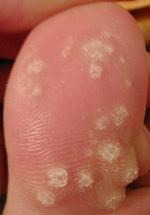What Causes Common Warts? - The basics of common wart infection, susceptibility factors, and transmission.
On Apr 23, 2013
-
Keypoint Tweet @CentralSkin: Common warts, a common problem without an easy solution.
-
What are they? Common warts are benign (non-cancerous) skin growths caused by the human papillomavirus (HPV). Common warts are also called verrucae vulgaris. In fact, the word "vulgaris" has origins in the Latin language where it means "common." They are called common warts to differentiate them from genital warts, which are also caused by HPV, albeit different subtypes. There are over 100 different subtypes of HPV. However, knowledge of the subtypes is more important when dealing with genital warts, since certain subtypes of HPV (subtypes 6, 11, 16 18, 31, 35) can lead to cervical cancer in women. Common warts are frequently found on the hands, fingers, and under the nails. In children common warts can also be seen on other contact points such as the knees and elbows.
 Multiple common warts on the big toeImage source: Wikipedia
Multiple common warts on the big toeImage source: Wikipedia -
Just how common are common warts? Very common indeed. They are found in children and adults in many different climates and countries across the world. While the exact number of people infected is unknown, common warts affect approximately 7-12% of the population. In fact, their prevalence in school age children is even higher at 10-20%. Some estimates suggest that 1 in 5 school kids will at some time develop a wart.
-
How does the virus cause the wart to form? The virus infects the skin cells, or keratinocytes, and establishes itself in the basal layer of the skin. HPV infection of the keratinocytes results in increased proliferation of the skin cells, which causes the top layers of the skin to become thickened, and corrugated. This gives the classic appearance to a wart. In essence, HPV uses our human body to produce a protective "shield" of skin for itself. This allows the virus to keep replicating without harm from the environment or from its unbeknownst human host.
-
How are common warts transmitted? Transmission of the virus occurs mostly through physical contact such as from handshaking. The virus can also be transmitted by skin contact with fomites, or inanimate objects onto which the virus was shed. HPV has been found on many fomites such as clothing, doorknobs, books, toys, hand railings, the floor of locker rooms and swimming pools. So in effect HPV can be easily transmitted directly person-to-person or indirectly as person-object-person. As a result of the ease of transmission of HPV, it is no surprise that once one family member gets a common wart, other family members are soon to follow. When it comes to HPV, misery loves company.
- Who is susceptible to HPV infection?
- Anyone in close contacts with children or adults who have warts or have recently been treated for warts
- Anyone who handles raw meat, fish, or other animal matter such as butchers or fishmongers
- People who are immunocompromised due to infection with HIV/AIDS or due to any other immunosuppressive diseases like lymphomas
- Transplant recipients who take immunosuppressive medications. Although these medications prevent transplant rejection, they predispose transplant recipients to infections due to suppression of their immune system.
- Anyone taking any drugs that suppress their immune system. For example, people taking oral steroids for a severe asthma exacerbation or a rheumatologic condition such as rheumatoid arthritis. Also, many chemotherapeutic medications taken by cancer patients suppress the immune system and predispose the patients to HPV and other infectious agents.
- The bottom line: Common warts results from an infection from the human papillomavirus. HPV infection results in increased layers of skin formation in the area of infection, which leading to the rough and firm appearance of warts. It is easy to spread warts by direct physical contact or by contact with physical objects which were handled by someone with warts. People who are predisposed to getting warts include the immunosuppressed or individuals in close contact with people with warts, such as family members. Warts are very hard to treat and frequently relapse after successful treatment. Learn more about the treatment of common warts by reading our follow-up article, "What Are The Treatments for Common Warts? - Home Remedies and Treatments at the Doctor's Office."
References:


Comments
Leave a Comment